Early Retinal Microvascular Alterations in Young Type 1 Diabetic Patients without Clinical Retinopathy
Abstract
1. Introduction
2. Materials and Methods
2.1. Patients
2.2. Ophthalmic Examination
2.3. Statistical Analysis
3. Results
T1D Group Analysis
4. Discussion
5. Conclusions
Author Contributions
Funding
Institutional Review Board Statement
Informed Consent Statement
Data Availability Statement
Conflicts of Interest
References
- Gujral, U.P.; Narayan, K.M.V. Diabetes in Normal-Weight Individuals: High Susceptibility in Nonwhite Populations. Diabetes Care 2019, 42, 2164–2166. [Google Scholar] [CrossRef]
- Gregory, G.A.; Robinson, T.I.G.; Linklater, S.E.; Wang, F.; Colagiuri, S.; de Beaufort, C.; Donaghue, K.C.; International Diabetes Federation Diabetes Atlas Type 1 Diabetes in Adults Special Interest Group; Magliano, D.J.; Maniam, J.; et al. Global incidence, prevalence, and mortality of type 1 diabetes in 2021 with projection to 2040: A modelling study. Lancet Diabetes Endocrinol. 2022, 10, 741–760. [Google Scholar] [CrossRef] [PubMed]
- Norris, J.M.; Johnson, R.K.; Stene, L.C. Type 1 diabetes-early life origins and changing epidemiology. Lancet Diabetes Endocrinol. 2020, 8, 226–238. [Google Scholar] [CrossRef] [PubMed]
- Wysocka-Mincewicz, M.; Baszyńska-Wilk, M.; Gołębiewska, J.; Olechowski, A.; Byczyńska, A.; Hautz, W.; Szalecki, M. Influence of Metabolic Parameters and Treatment Method on OCT Angiography Results in Children with Type 1 Diabetes. J. Diabetes Res 2020, 2020, 4742952. [Google Scholar] [CrossRef]
- Forga Llenas, L.; Goñi Iriarte, M.J.; Cambra Contin, K.; Ibáñez Beroiz, B.; Chueca Guendulain, M.; Berrade Zubiri, S. Incidence and temporal trends of childhood type 1 diabetes between 1975 and 2012 in Navarre (Spain). Gac. Sanit. 2015, 29, 51–54. [Google Scholar] [CrossRef]
- Rewers, M.; Ludvigsson, J. Environmental risk factors for type 1 diabetes. Lancet 2016, 387, 2340–2348. [Google Scholar] [CrossRef]
- Predieri, B.; Bruzzi, P.; Bigi, E.; Ciancia, S.; Madeo, S.F.; Lucaccioni, L.; Iughetti, L. Endocrine Disrupting Chemicals and Type 1 Diabetes. Int. J. Mol. Sci. 2020, 21, 2937. [Google Scholar] [CrossRef] [PubMed]
- Danielescu, C.; Moraru, A.D.; Anton, N.; Bilha, M.-I.; Donica, V.-C.; Darabus, D.-M.; Munteanu, M.; Stefanescu-Dima, A.S. The Learning Curve of Surgery of Diabetic Tractional Retinal Detachment—A Retrospective, Comparative Study. Medicina 2023, 59, 73. [Google Scholar] [CrossRef]
- Ou, C.; Yang, Y.J.; Peng, Q.H. Yiqi Yangyin Huoxue Method in Treating Diabetic Retinopathy: A Systematic Review and Meta-Analysis. Evid. Based Complement. Altern. Med. 2019, 2019, 6020846. [Google Scholar] [CrossRef]
- Simó-Servat, O.; Hernández, C.; Simó, R. Diabetic Retinopathy in the Context of Patients with Diabetes. Ophthalmic Res 2019, 62, 211–217. [Google Scholar] [CrossRef] [PubMed]
- Veiby, N.C.B.B.; Simeunovic, A.; Heier, M.; Brunborg, C.; Saddique, N.; Moe, M.C.; Dahl-Jørgensen, K.; Margeirsdottir, H.D.; Petrovski, G. Associations between Macular OCT Angiography and Nonproliferative Diabetic Retinopathy in Young Patients with Type 1 Diabetes Mellitus. J. Diabetes Res. 2020, 2020, 8849116. [Google Scholar] [CrossRef] [PubMed]
- Wysocka-Mincewicz, M.; Gołębiewska, J.; Olechowski, A.; Szalecki, M. Diabetic Retinopathy in Children with Type 1 Diabetes-Occurrence and Screening Using Optical Coherence Tomography. Life 2021, 11, 590. [Google Scholar] [CrossRef]
- Inanc, M.; Tekin, K.; Kiziltoprak, H.; Ozalkak, S.; Doguizi, S.; Aycan, Z. Changes in Retinal Microcirculation Precede the Clinical Onset of Diabetic Retinopathy in Children with Type 1 Diabetes Mellitus. Am. J. Ophthalmol. 2019, 207, 37–44. [Google Scholar] [CrossRef]
- Zhang, B.; Chou, Y.; Zhao, X.; Yang, J.; Chen, Y. Early Detection of Microvascular Impairments With Optical Coherence Tomography Angiography in Diabetic Patients Without Clinical Retinopathy: A Meta-analysis. Am. J. Ophthalmol. 2021, 222, 226–237. [Google Scholar] [CrossRef] [PubMed]
- Hagag, A.M.; Gao, S.S.; Jia, Y.; Huang, D. Optical coherence tomography angiography: Technical principles and clinical applications in ophthalmology. Taiwan J. Ophthalmol. 2017, 7, 115–129. [Google Scholar] [PubMed]
- Grzybowski, A.; Brona, P.; Lim, G.; Ruamviboonsuk, P.; Tan, G.S.W.; Abramoff, M.; Ting, D.S.W. Artificial intelligence for diabetic retinopathy screening: A review. Eye 2020, 34, 451–460. [Google Scholar] [CrossRef]
- Mavrogiorgou, A.; Kiourtis, A.; Kleftakis, S.; Mavrogiorgos, K.; Zafeiropoulos, N.; Kyriazis, D. A Catalogue of Machine Learning Algorithms for Healthcare Risk Predictions. Sensors 2022, 22, 8615. [Google Scholar] [CrossRef]
- Bidwai, P.; Gite, S.; Pahuja, K.; Kotecha, K. A Systematic Literature Review on Diabetic Retinopathy Using an Artificial Intelligence Approach. Big Data Cogn. Comput. 2022, 6, 152. [Google Scholar] [CrossRef]
- Song, S.H. Complication characteristics between young-onset type 2 versus type 1 diabetes in a UK population. BMJ Open Diabetes Res. Care 2015, 3, e000044. [Google Scholar] [CrossRef]
- Qureshi, I.; Ma, J.; Abbas, Q. Recent Development on Detection Methods for the Diagnosis of Diabetic Retinopathy. Symmetry 2019, 11, 749. [Google Scholar] [CrossRef]
- Kushner-Lenhoff, S.; Kogachi, K.; Mert, M.; Chu, Z.; Shahidzadeh, A.; Palejwala, N.V.; Wolfe, J.; Itty, S.; Drenser, K.A.; Capone, A., Jr.; et al. Capillary density and caliber as assessed by optical coherence tomography angiography may be significant predictors of diabetic retinopathy severity. PLoS ONE 2022, 17, e0262996. [Google Scholar] [CrossRef] [PubMed]
- Couturier, A.; Rey, P.A.; Erginay, A.; Lavia, C.; Bonnin, S.; Dupas, B.; Gaudric, A.; Tadayoni, R. Widefield OCT-Angiography and Fluorescein Angiography Assessments of Nonperfusion in Diabetic Retinopathy and Edema Treated with Anti-Vascular Endothelial Growth Factor. Ophthalmology 2019, 126, 1685–1694. [Google Scholar] [CrossRef]
- Anvari, P.; Najafi, A.; Mirshahi, R.; Sardarinia, M.; Ashrafkhorasani, M.; Kazemi, P.; Aghai, G.; Habibi, A.; Falavarjani, K.G. Superficial and Deep Foveal Avascular Zone Area Measurement in Healthy Subjects Using Two Different Spectral Domain Optical Coherence Tomography Angiography Devices. J. Ophthalmic. Vis. Res. 2020, 15, 517–523. [Google Scholar]
- Bresnick, G.H.; Condit, R.; Syrjala, S.; Palta, M.; Groo, A.; Korth, K. Abnormalities of the foveal avascular zone in diabetic retinopathy. Arch. Ophthalmol. 1984, 102, 1286–1293. [Google Scholar] [CrossRef] [PubMed]
- Takase, N.; Nozaki, M.; Kato, A.; Ozeki, H.; Yoshida, M.; Ogura, Y. Enlargement of foveal avascular zone in diabetic eyes evaluated by en face optical coherence tomography angiography. Retina 2015, 35, 2377–2383. [Google Scholar] [CrossRef] [PubMed]
- Gołębiewska, J.; Olechowski, A.; Wysocka-Mincewicz, M.; Odrobina, D.; Baszyńska-Wilk, M.; Groszek, A.; Szalecki, M.; Hautz, W. Optical coherence tomography angiography vessel density in children with type 1 diabetes. PLoS ONE 2017, 12, e0186479. [Google Scholar] [CrossRef]
- Picano, E.; Mangia, C.; D’Andrea, A. Climate Change, Carbon Dioxide Emissions, and Medical Imaging Contribution. J. Clin. Med. 2023, 12, 215. [Google Scholar] [CrossRef]
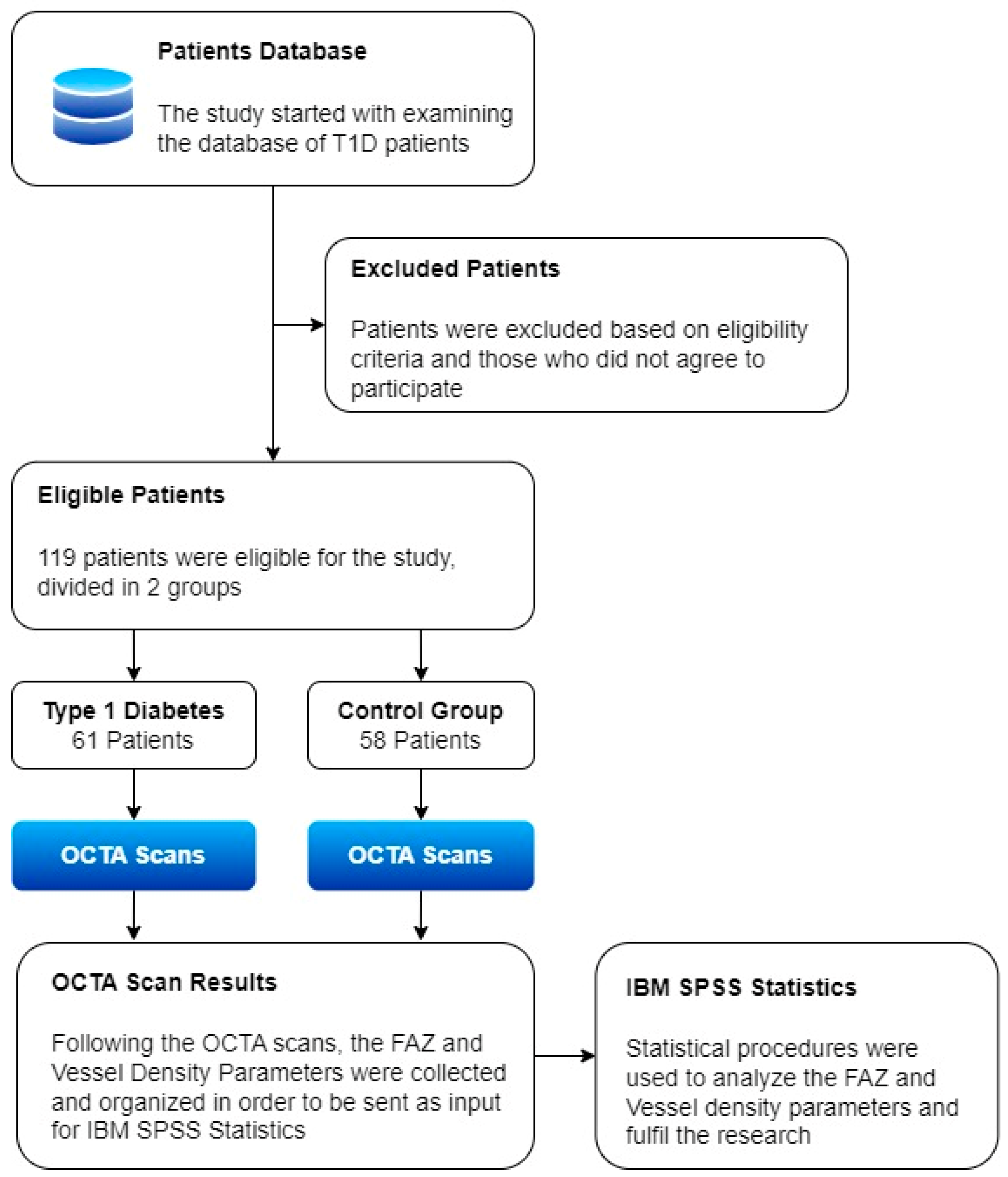
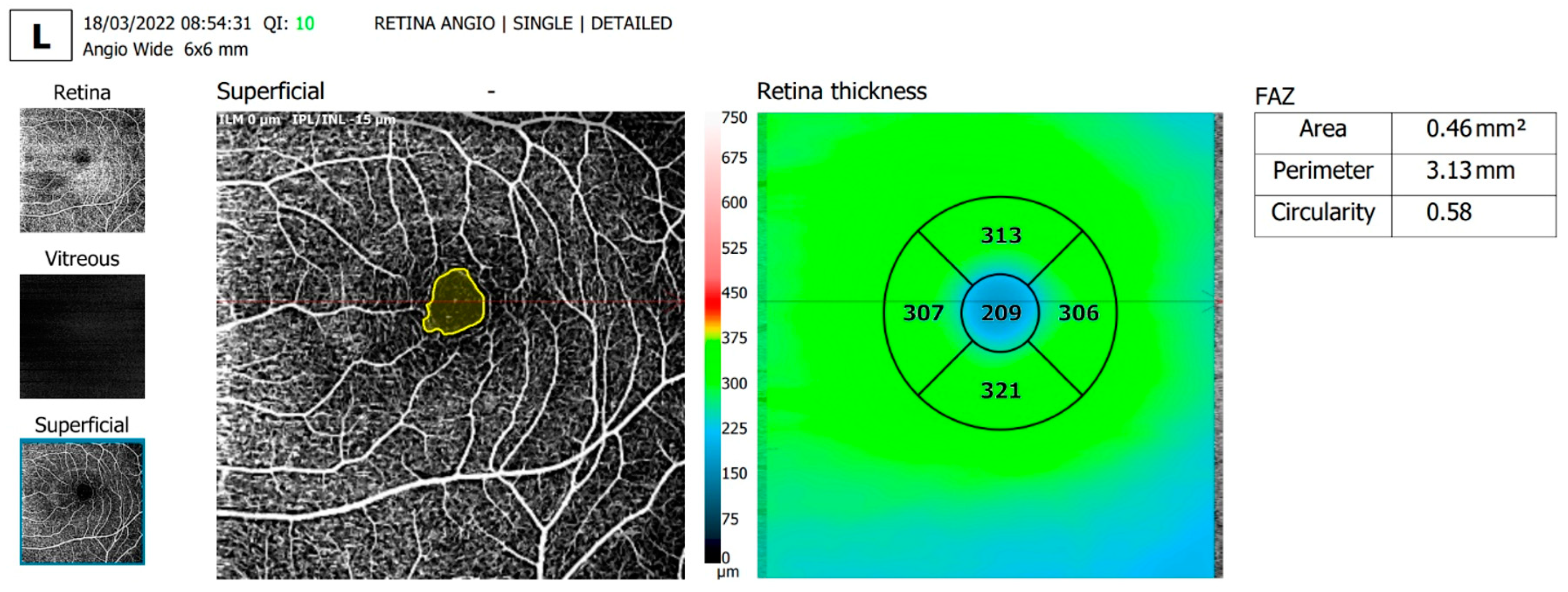
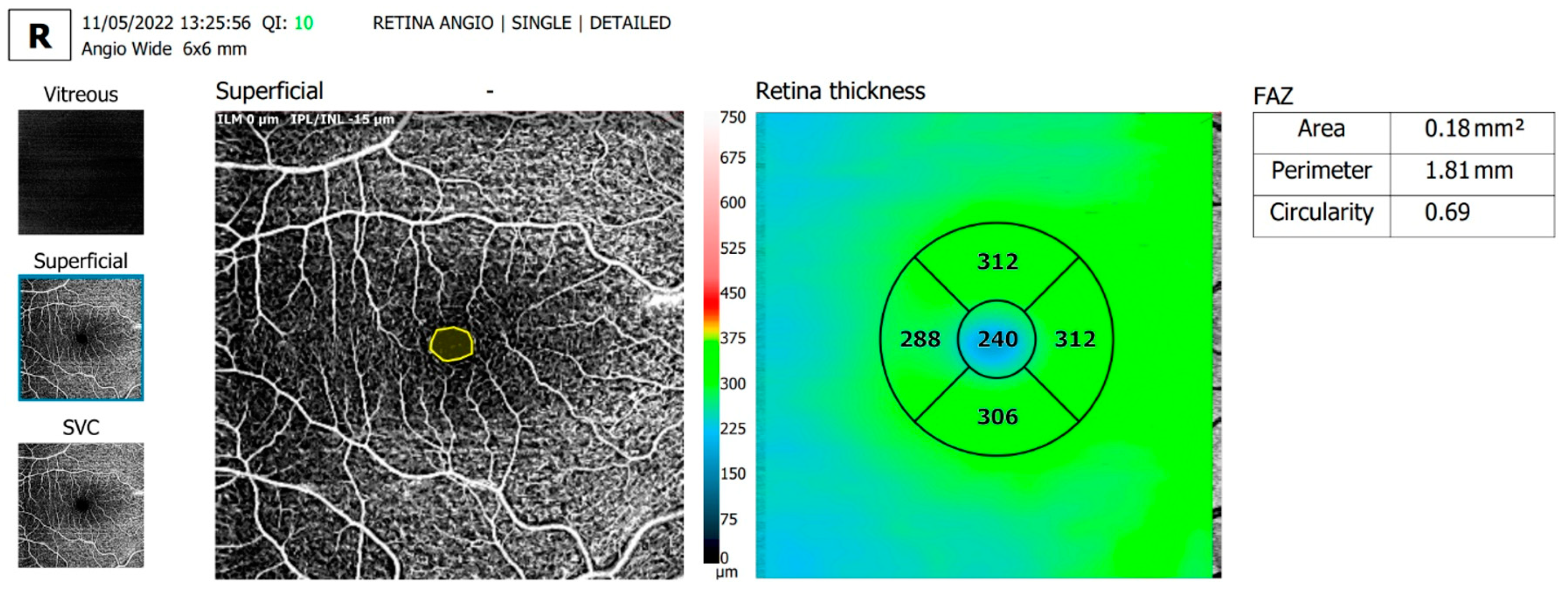
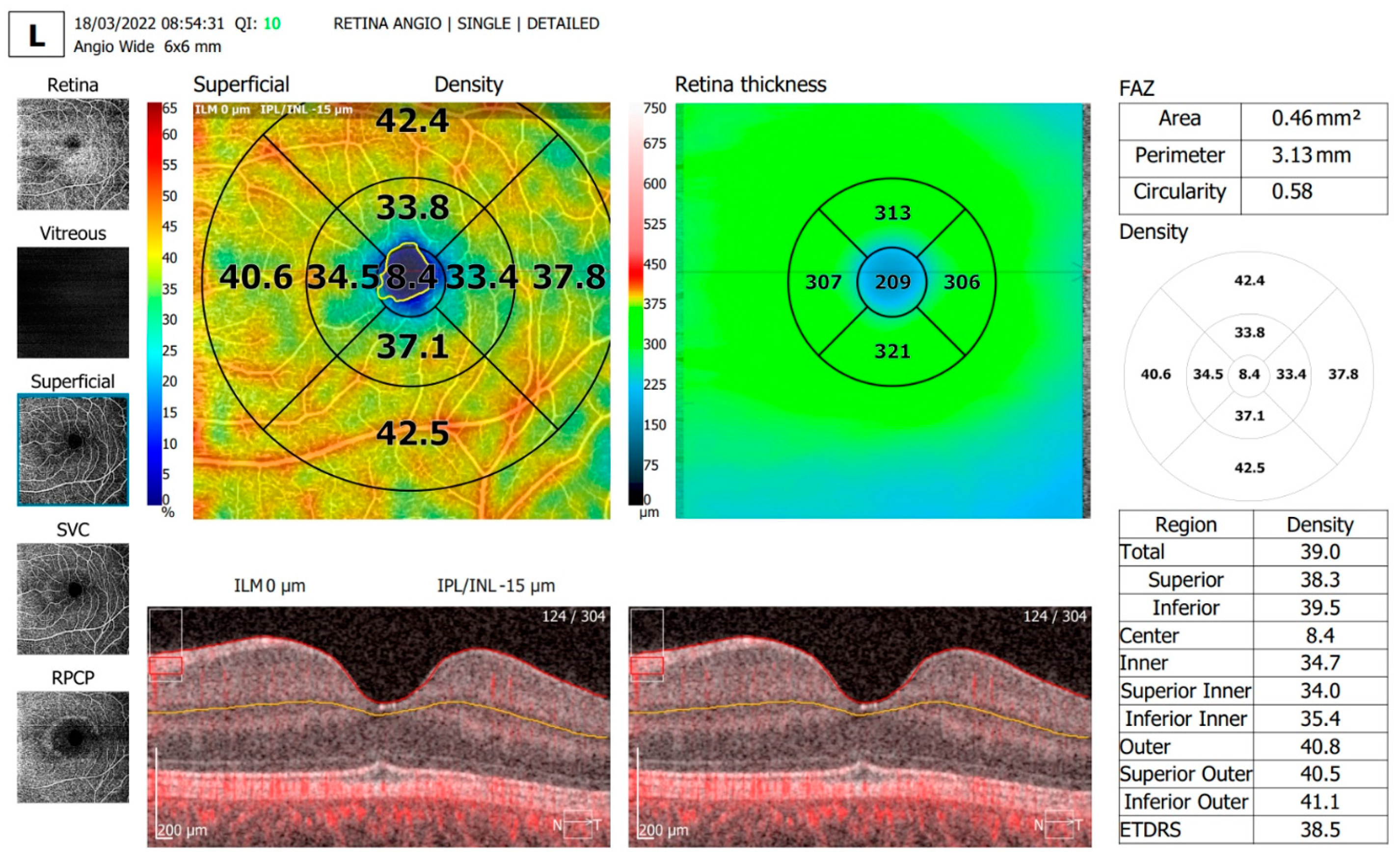
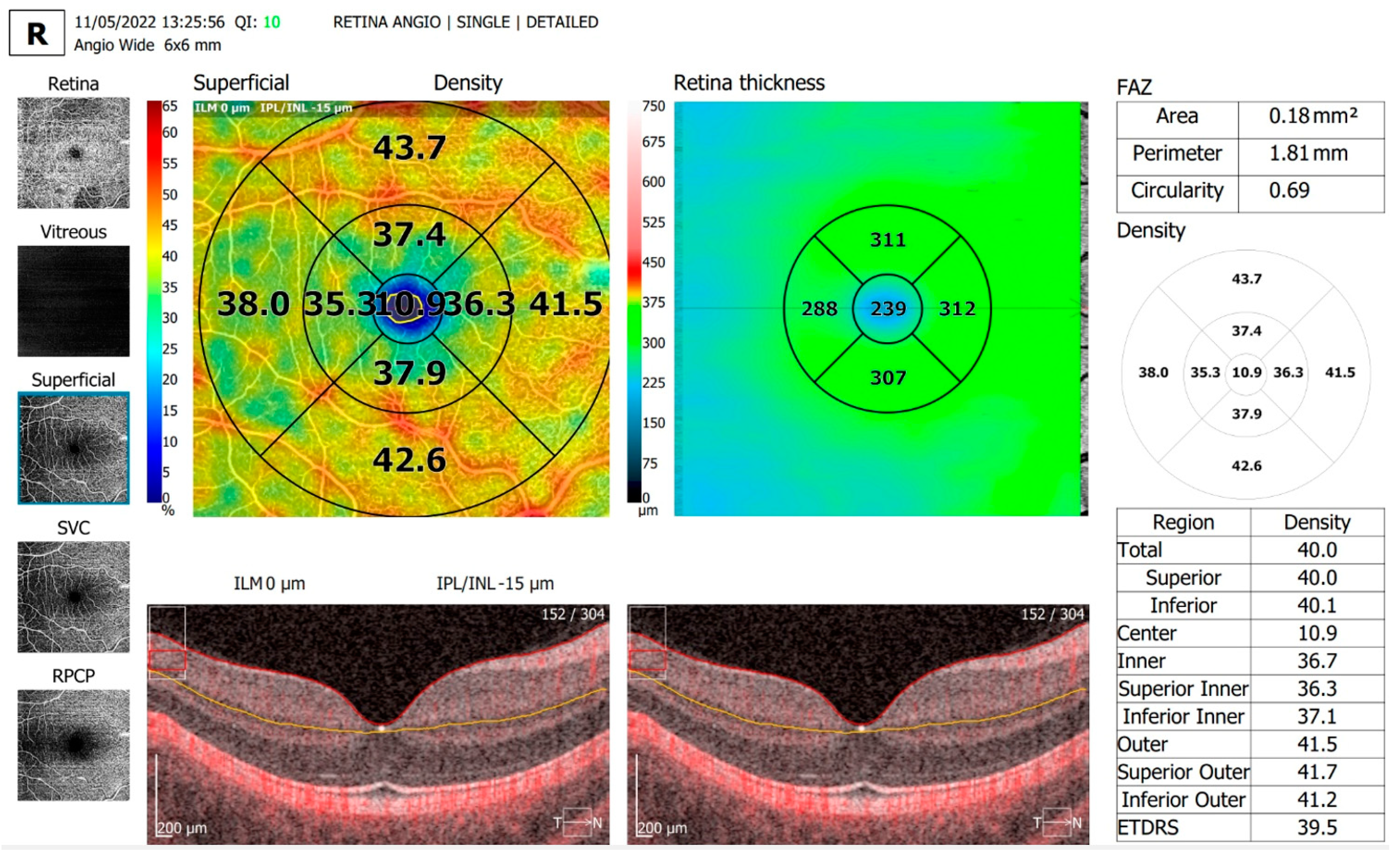
| Group | Participants | Age (Mean ± SD) (Years) | ||||
|---|---|---|---|---|---|---|
| F | M | Overall | F | M | Overall | |
| Control group | 30 (55.56%) | 28 (43.08%) | 58 | 14.00 ± 5.589 | 13.96 ± 4.842 | 13.98 ± 5.196 |
| T1D group | 24 (44.44%) | 37 (56.92%) | 61 | 12.00 ± 5.898 | 12.54 ± 3.927 | 12.33 ± 4.760 |
| TOTAL | 54 (100%) | 65 (100%) | 119 | 13.11 ± 5.762 | 13.15 ± 4.367 | 13.13 ± 5.025 |
| Parameter | T1D Group Mean ± SD (min–max) | Control Group Mean ± SD (min–max) | p |
|---|---|---|---|
| FAZ Area | 0.4238 ± 0.1755 (0.14–1.27) | 0.2695 ± 0.08495 (0.09–0.60) | <0.0005 * |
| FAZ Circularity ** | 0.4148 ± 0.1105 (0.22–0.68) | 0.6193 ± 0.0849 (0.34–0.79) | <0.0005 ** |
| FAZ Perimeter | 3.6334 ± 0.9762 (2.07–7.24) | 2.3026 ± 0.5015 (1.32–3.86) | <0.0005 * |
| VD Superficial Region Total | 37.4164 ± 2.1424 (30.70–41.30) | 38.0241 ± 2.4478 (28.80–41.30) | 0.037 * |
| VD Superficial Region Superior | 37.5885 ± 2.2630 (31.30–41.70) | 38.0707 ± 2.9022 (27.60–42.50) | 0.043 * |
| VD Superficial Region Inferior | 37.3295 ± 2.5328 (28.30–40.80) | 37.8793 ± 3.0998 (25.80–41.00) | 0.024 * |
| VD Superficial Region Center | 13.5475 ± 5.1868 (4.40–28.80) | 13.0828 ± 6.5091 (3.60–35.20) | 0.413 * |
| VD Superficial Region Inner ** | 36.2656 ± 3.2766 (29.60–42.80) | 35.4862 ± 3.6417 (26.10–42.50) | 0.222 ** |
| VD Superficial Region Superior Inner | 36.7754 ± 3.4899 (27.80–43.10) | 35.8155 ± 4.2219 (21.00–42.90) | 0.239 * |
| VD Superficial Region Inferior Inner ** | 35.7426 ± 3.4031 (29.60–42.60) | 35.1621 ± 3.8549 (26.20–42.50) | 0.385 ** |
| VD Deep Region Total | 41.5738 ± 1.5151 (36.90–43.70) | 41.2690 ± 2.3644 (28.80–43.80) | 0.532 * |
| VD Deep Region Superior | 41.6672 ± 1.8051 (35.90–44.10) | 41.1466 ± 2.7237 (27.40–43.90) | 0.312 * |
| VD Deep Region Inferior | 41.4049 ± 1.8256 (33.20–43.50) | 41.3276 ± 2.6060 (30.00–44.20) | 0.520 * |
| VD Deep Region Center ** | 29.9246 ± 4.2637 (21.30–37.70) | 29.2534 ± 4.9685 (13.20–39.50) | 0.430 ** |
| VD Deep Region Inner | 43.1246 ± 1.1856 (38.30–45.20) | 42.7293 ± 1.8152 (35.70–45.10) | 0.413 * |
| VD Deep Region Superior Inner | 43.3098 ± 1.1874 (38.90–45.50) | 42.7483 ± 2.1036 (32.40–44.80) | 0.203 * |
| VD Deep Region Inferior Inner | 42.9328 ± 1.4653 (35.80–44.90) | 42.6966 ± 2.1772 (33.20–45.40) | 0.968 * |
| Overall Foveal Thickness | 230.64 ± 20.8200 (190.00–298.00) | 222.98 ± 17.3360 (190.00–269.00) | 0.046 * |
| Investigative Traits | T1D Group |
|---|---|
| T1D duration (mean ± SD) (months) | 56.05 ± 53.450 |
| Age at onset of T1D (years old) | 7.34 ± 3.80 |
| Weight (kg) | 45.97 ± 20.39 |
| Height (cm) | 149.1 ± 20.42 |
| BMI (kg/m2) | 19.70 ± 4.75 |
| HbA1C at onset (%) | 12.16 ± 2.18 |
| HbA1C mean value (%) | 7.53 ± 1.42 |
| Parameter | T1D Duration (Mean ± SD) | ||
|---|---|---|---|
| <5 Years | ≥5 Years | p | |
| Area | 0.4281 ± 0.1937 | 0.4142 ± 0.1306 | 0.938 * |
| Circularity ** | 0.4188 ± 0.1176 | 0.4058 ± 0.0951 | 0.674 ** |
| Perimeter | 3.6440 ± 1.0771 | 3.6100 ± 0.7301 | 0.651 * |
| Superficial Region Total | 37.1524 ± 2.2555 | 38.0000 ± 1.7857 | 0.168 * |
| Superficial Region Superior | 37.3333 ± 2.4663 | 38.1526 ± 1.6517 | 0.246 * |
| Superficial Region Inferior | 37.0810 ± 2.6469 | 37.8789 ± 2.2275 | 0.265 * |
| Superficial Region Center | 13.2714 ± 5.5036 | 14.1579 ± 4.4847 | 0.323 * |
| Superficial Region Inner ** | 35.7524 ± 3.4983 | 37.4000 ± 2.4367 | 0.069 ** |
| Superficial Region Superior Inner | 36.3357 ± 3.8589 | 37.7474 ± 2.2867 | 0.175 * |
| Superficial Region Inferior Inner ** | 35.1381 ± 3.5160 | 37.0789 ± 2.7760 | 0.058 ** |
| Deep Region Total | 41.3643 ± 1.6629 | 42.0368 ± 1.0122 | 0.103 * |
| Deep Region Superior | 41.5024 ± 1.9724 | 42.0316 ± 1.3400 | 0.354 * |
| Deep Region Inferior | 41.1405 ± 1.9650 | 41.9895 ± 1.3378 | 0.063 * |
| Deep Region Center ** | 29.3262 ± 4.1300 | 31.2474 ± 4.3660 | 0.104 * |
| Deep Region Inner | 42.9833 ± 1.3079 | 43.4368 ± 0.7994 | 0.207 * |
| Deep Region Superior Inner | 43.1762 ± 1.3207 | 43.6053 ± 0.7699 | 0.230 * |
| Deep Region Inferior Inner | 42.7762 ± 1.6292 | 43.2789 ± 0.9629 | 0.221 * |
Disclaimer/Publisher’s Note: The statements, opinions and data contained in all publications are solely those of the individual author(s) and contributor(s) and not of MDPI and/or the editor(s). MDPI and/or the editor(s) disclaim responsibility for any injury to people or property resulting from any ideas, methods, instructions or products referred to in the content. |
© 2023 by the authors. Licensee MDPI, Basel, Switzerland. This article is an open access article distributed under the terms and conditions of the Creative Commons Attribution (CC BY) license (https://creativecommons.org/licenses/by/4.0/).
Share and Cite
Dan, A.O.; Ștefănescu-Dima, A.; Bălășoiu, A.T.; Puiu, I.; Mocanu, C.L.; Ionescu, M.; Tănasie, A.C.; Târtea, A.E.; Sfredel, V. Early Retinal Microvascular Alterations in Young Type 1 Diabetic Patients without Clinical Retinopathy. Diagnostics 2023, 13, 1648. https://doi.org/10.3390/diagnostics13091648
Dan AO, Ștefănescu-Dima A, Bălășoiu AT, Puiu I, Mocanu CL, Ionescu M, Tănasie AC, Târtea AE, Sfredel V. Early Retinal Microvascular Alterations in Young Type 1 Diabetic Patients without Clinical Retinopathy. Diagnostics. 2023; 13(9):1648. https://doi.org/10.3390/diagnostics13091648
Chicago/Turabian StyleDan, Alexandra Oltea, Alin Ștefănescu-Dima, Andrei Teodor Bălășoiu, Ileana Puiu, Carmen Luminița Mocanu, Mihaela Ionescu, Andreea Cornelia Tănasie, Anca Elena Târtea, and Veronica Sfredel. 2023. "Early Retinal Microvascular Alterations in Young Type 1 Diabetic Patients without Clinical Retinopathy" Diagnostics 13, no. 9: 1648. https://doi.org/10.3390/diagnostics13091648
APA StyleDan, A. O., Ștefănescu-Dima, A., Bălășoiu, A. T., Puiu, I., Mocanu, C. L., Ionescu, M., Tănasie, A. C., Târtea, A. E., & Sfredel, V. (2023). Early Retinal Microvascular Alterations in Young Type 1 Diabetic Patients without Clinical Retinopathy. Diagnostics, 13(9), 1648. https://doi.org/10.3390/diagnostics13091648






